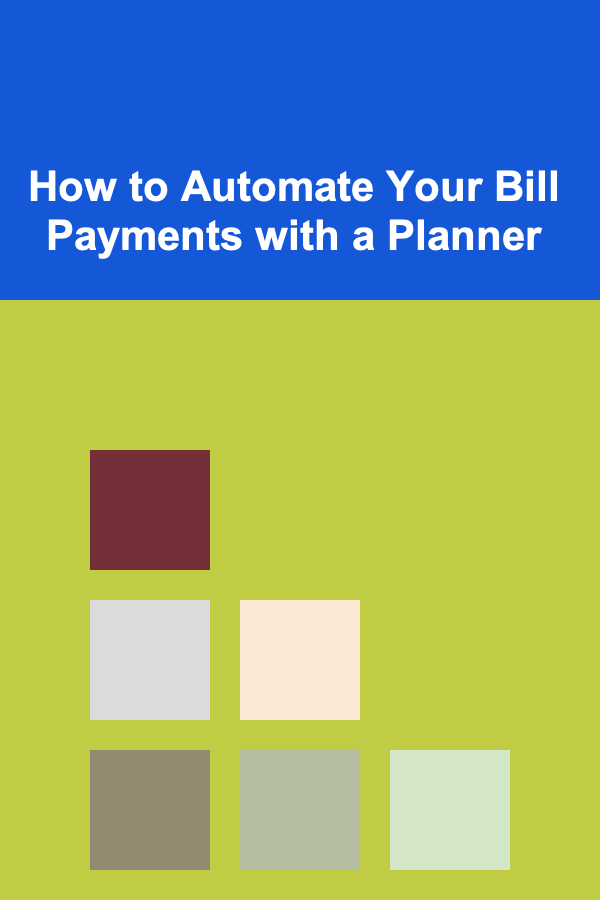
How to Automate Your Bill Payments with a Planner
ebook include PDF & Audio bundle (Micro Guide)
$12.99$8.99
Limited Time Offer! Order within the next:

Managing your finances can often feel overwhelming, especially when juggling multiple bills, payments, and deadlines. If you're constantly stressed about missing due dates, forgetting payments, or falling behind on your financial obligations, automating your bill payments could be a game-changer. By setting up automatic payments, you can ensure that your bills are always paid on time, avoid late fees, and free up mental space for other priorities.
One of the best ways to make bill payments even easier to manage is by using a planner. A planner---whether physical or digital---can help you track your payment dates, ensure that everything is accounted for, and set reminders. The combination of automation and organization through a planner offers a powerful way to keep your finances in check and avoid financial mishaps.
In this article, we'll explore the steps to automate your bill payments using a planner. We'll cover everything from choosing the right tools to setting up automatic payments and maintaining a plan that ensures you stay financially organized. Let's dive into the process and discover how automating your bill payments can save you time, reduce stress, and enhance your financial well-being.
Why Automate Bill Payments?
Before we dive into the process of automating bill payments with a planner, it's essential to understand the benefits of automation. Automating your bills can offer several advantages, such as:
Benefits of Automating Bill Payments:
- Time-Saving: Automation eliminates the need to remember every bill's due date or manually process payments each month. Once set up, automatic payments happen without your intervention.
- Reduced Stress: Forgetting a bill or missing a payment deadline can create unnecessary stress. With automation, you can rest easy knowing that your bills are paid on time.
- Avoid Late Fees: Missing a payment or paying late can result in penalties, late fees, and potential damage to your credit score. Automating payments ensures you never incur these unnecessary costs.
- Improved Cash Flow Management: Automation makes it easier to manage your budget because you know exactly when payments will be deducted. This helps with forecasting expenses and planning your budget more effectively.
- Increased Financial Discipline: By setting up automated payments, you create a system of accountability and discipline for your finances. You're more likely to stay on top of your financial goals and prevent unnecessary spending.
Now that you understand why automation is beneficial, let's dive into how you can use a planner to make this process even more seamless.
Choosing the Right Planner for Bill Management
The first step to automating your bill payments with a planner is choosing the right one. Planners can be divided into two main categories: physical planners and digital planners. Both have their advantages and disadvantages, so it's essential to choose one that fits your lifestyle and preferences.
Physical Planners
Physical planners are traditional, paper-based systems that you can carry with you. They are perfect for those who prefer a tactile, offline method of organization. These planners often include monthly or weekly spreads, space for tracking bills, and other features to help you stay on top of payments.
Pros of Physical Planners:
- Tangible and easy to use without the need for technology.
- Can be customized with stickers, notes, and reminders.
- Encourages mindful planning and can serve as a more personal, creative outlet.
Cons of Physical Planners:
- May require manual updates and note-taking.
- Cannot send you reminders or alerts for upcoming bills automatically.
- Can be easily misplaced or forgotten at home.
Digital Planners
Digital planners are cloud-based applications or tools that you can access from your phone, tablet, or computer. Popular examples include Google Calendar, Notion, Todoist, and Microsoft Outlook. Digital planners come with the benefit of being synchronized across all devices, sending reminders, and automating some aspects of your financial organization.
Pros of Digital Planners:
- Easily accessible across all your devices.
- Can send automatic reminders and alerts.
- Allows for quick updates and adjustments.
- Can integrate with online banking and budgeting apps.
Cons of Digital Planners:
- Requires technology and internet access.
- May require learning how to use a new app or interface.
Both types of planners are excellent tools for bill management, and the best one depends on your personal preferences and lifestyle. If you love the feel of paper and prefer handwritten notes, a physical planner might be the way to go. On the other hand, if you want convenience, alerts, and the ability to sync your planner across multiple devices, a digital planner may be a better fit.
Setting Up Automatic Bill Payments
Once you've selected your planner, it's time to set up automatic bill payments. The goal here is to minimize the amount of time and energy you spend on remembering when and how to pay bills. Let's break down the steps involved.
Step 1: List Your Bills
The first step is to compile a comprehensive list of all your bills. This will give you a clear overview of what you're working with and ensure you don't miss anything important. For each bill, make note of the following:
- Bill name (e.g., rent, utilities, credit card, subscription service)
- Amount due (fixed or variable)
- Due date
- Billing cycle (monthly, quarterly, annually)
- Payment method (e.g., direct deposit, credit card, bank transfer)
This information will serve as the foundation for setting up automation.
Step 2: Set Up Automatic Payments with Providers
After you've listed your bills, the next step is to contact your bill providers and set up automatic payments. Many companies offer this option on their websites or via customer service.
Most utility providers, subscription services, and loan companies will allow you to link your bank account, credit card, or debit card to their billing system. Once linked, you can opt for automatic payments, which will be deducted from your account on the due date.
Step 3: Schedule Reminders in Your Planner
Even though automation will handle the payments, it's still essential to have a system for keeping track of when the payments will occur. In your planner, you can schedule recurring reminders for each bill. These reminders should be set a few days before the payment is due so you can ensure there are enough funds in your account and resolve any issues if needed.
For digital planners, you can set these reminders as recurring events. For example, in Google Calendar, you can set up a reminder with a notification alert that pops up a few days before each payment is due.
Step 4: Verify Payments
While automation helps prevent missed payments, it's always a good idea to periodically check your accounts to make sure everything is running smoothly. This could mean reviewing your bank account or credit card statement to ensure that automatic deductions are happening correctly.
Step 5: Maintain Flexibility for Changes
Life changes, and so do your bills. If you get a new service, increase or decrease your subscriptions, or change your payment method, be sure to update your planner and make adjustments to your automatic payments accordingly.
Track Your Bills and Budgeting
Once you have automated your bill payments, it's important to continue tracking your bills and ensuring they fit into your overall financial plan. A planner is an essential tool for staying on top of your budget and keeping your financial goals in check.
Here are a few ways you can track your bills in your planner:
1. Monthly Bill Tracker
Create a simple monthly bill tracker in your planner. This could be a table or list where you write down each bill, its due date, and whether it has been paid. Digital planners allow you to color-code or mark off bills that have been paid, making it easier to see at a glance what's due and what's been taken care of.
2. Set Up a Budgeting System
Using a planner for budgeting can help you see where your bill payments fit within your overall financial picture. You can use tools like the "50/30/20 Rule" or the "Zero-Based Budget" method to allocate your income to essential bills, savings, and discretionary expenses.
Tracking your bills within your overall budget will help you avoid overspending and ensure that you have enough funds to cover your automated payments.
3. Create a Debt Repayment Plan
If you have debt, using your planner to track your payments will help ensure that you don't miss any deadlines and make progress toward reducing your balances. You can set up automatic payments for your debts as well, and your planner can help you monitor your debt-to-income ratio and track your progress.
The Importance of Backup Plans
While automation can significantly reduce the risk of missed payments, it's crucial to have a backup plan in case something goes wrong. Ensure you have sufficient funds in your bank account to cover automated payments, and have an emergency savings fund for unexpected situations.
Final Thoughts on Automating Bill Payments with a Planner
Automating bill payments is one of the most effective ways to streamline your financial life. By using a planner---whether digital or physical---you can stay organized, avoid missing payments, and ensure that your finances run smoothly. With the right tools, a bit of planning, and some discipline, you'll find that managing your bills is easier, less stressful, and more efficient.
By using both automation and organization, you can free up mental space, improve your cash flow management, and focus on reaching your broader financial goals. Whether you're paying rent, utilities, or credit cards, automating your bill payments and tracking them in a planner is a step toward financial peace of mind.
Reading More From Our Other Websites
- [Home Pet Care 101] How to Keep Your Pet's Toys and Supplies Organized at Home
- [Home Space Saving 101] How to Choose Multi-Functional Furniture for Small Spaces
- [Home Renovating 101] How to Renovate Your Home with a Minimalist Approach
- [Home Soundproofing 101] How to Soundproof a Kitchen: Tips for Reducing Noise in Your Cooking Space
- [Organization Tip 101] How to Plan for Home Renovations Without the Chaos
- [Organization Tip 101] How to Use a Wall-Mounted Organizer in Your Kitchen
- [Organization Tip 101] How to Set Up a Functional Laundry Room for Ease
- [Organization Tip 101] How to Create a Capsule Wardrobe for Each Season
- [Organization Tip 101] How to Organize Your Laundry Room for Minimalist Living
- [Home Storage Solution 101] How to Conquer Basement Clutter: The Ultimate Guide to Basement Storage Solutions

How to Create a Sustainable Digital Filing System
Read More
How to Create an Efficient System for Grocery Shopping
Read More
How to Maximize Your Bathroom Storage with Creative Hacks
Read More
Top Tips for Minimizing Credit Card Debt Without Sacrificing Your Lifestyle
Read More
Crystal Healing for Sleep: 5 Powerful Combinations
Read More
10 Tips for Dealing with Inconsistent Child Support Payments
Read MoreOther Products

How to Create a Sustainable Digital Filing System
Read More
How to Create an Efficient System for Grocery Shopping
Read More
How to Maximize Your Bathroom Storage with Creative Hacks
Read More
Top Tips for Minimizing Credit Card Debt Without Sacrificing Your Lifestyle
Read More
Crystal Healing for Sleep: 5 Powerful Combinations
Read More